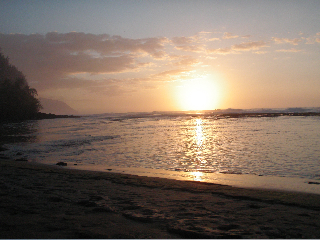
Na Pali Coastline on the island of Kauai. Credit: Jim Kruger
Having Ironman Triathlon World Championship races in my recent past didn’t mean I could hike all 22 miles of the Na Pali Coast to remote Kalalau Beach and back in one day. People thought I was a little nuts. My triathlon training partner, an experienced Kauai trekker, offered the most encouragement: I don’t know… you might make it? But I wanted peace, and for me the quest for serenity has never been about sitting still for extended periods. Rather, it revolves around finding and seizing quiet moments amid challenge and adventure.
Lured by the majestic scenery and the lore of the rigorous trail to a beach 11 miles deep into the north shore of Kauai — accessible only by foot or boat — I planned carefully. How much daylight? What kind of pace? How many calories and ounces of water? Did I have the right permits?
Because the Sierra Club rates the difficulty at 9 out of 10 (and, of course, it’s stunning, so why rush?), people usually stay overnight at Kalalau. However, several factors motivated me to attempt the round trip in one day: A lighter load and therefore a faster pace, and a suite at the hotel in Princeville, featuring a marble Jacuzzi tub with glass windows overlooking Hanalei Bay, high thread count linens instead of a tent, and steaks and seafood rather than protein bars.
I carried about 20 pounds of water, food, dry socks, headlamp, multi-tool, Gore-Tex shell, GPS and topographical map, first-aid kit, and a cell phone (useless, by the way) when I drove to the trailhead at Ke’e Beach.

The first light of day sent local roosters strutting and scurrying; an air of excitement hung between us as I lathered on sunscreen and bug repellent, and launched into the popular early miles to Hanakapi’ai Beach. Recent rains had soaked sections, sending me sliding through mud on my rear end at one point.
Na Pali means “Sea Cliffs” in Hawaiian, and these ridges soar 800 feet above the ocean in places. There are five valleys, and at the base of some, stone wall terraces where ancient Hawaiians cultivated taro plants still exist. The trail — sometimes narrow, treacherous, and exposed — pitched up or down the entire way. Occasionally, I navigated stream crossings under signs that left little to interpretation: “Warning: Strong Current. You could be swept away and could drown.”
As I gained and lost altitude at every turn, the terrain shifted from lush rain forest to barren, slippery silt, leading to some frightening areas. On one of these — a narrow trail with solid rock on one side and a sheer drop off on the other — I fought tears and struggled to regulate my breathing. Look where you want to go, I repeated in my head, unable to pull my gaze from the crumbly, disappearing edge that I was sure would leave my children motherless. I wanted to go back and order lunch by the pool. With a big basket of fries. But trails usually serve as apt metaphors for life. And going back, I reasoned, was not really how I wanted to live. So I inched forward, terrified, humbled, euphoric (well, that part came later).
After five and a half hours of moving at a solid clip, I caught the first glimpse of Kalalau Beach. Though my quadriceps quivered from the constant elevation changes, my spirit had found its equilibrium again. The red dust and rocks surrendered to a green, grassy hillside that afforded views of the coastline I had traversed. Crushing waves, a fixture on north shore beaches in winter, warned against entry into the ocean, even at the shallowest depths.

When I sat in the unmarred sand, it differed from all of the beaches that have formed the fabric of my life in the ocean. It was empty, save one shirtless fisherman casting into the surf, and his very naked female companion (trust me — it sounds more intriguing than it was), who seemed to wander in and out of his scope of attention.
I disappeared into my own space. I sat in silence and gratitude for a few minutes. Impossibly, my surroundings felt like both the edge of the earth and the center of everything in my life.
Yet it wasn’t perfect. There was also an uncomfortable element embodied in society drop-outs self-medicating in hammocks hidden among the trees, and the subtle feeling that I was trespassing. However, the tranquility that arose from the landscape, and the endorphins that got me there, overpowered the outsider status.

On the way back I managed the harrowing area (sort of), moving through with dry eyes and purpose. We arrived back at Ke’e Beach just in time to see the sun — fiery orange and appearing as though it might set in our laps — dip behind the whitewash blooming on the horizon. After removing my mud-caked shoes, I lowered myself into the cool, shallow water.

The next morning I awoke immobilized by my aching body and the arresting view. Across the 820 square-foot room, past the console where the flat screen TV disappeared, past a full living area with windows that also slid away, reality looked like a photograph. It seemed like I could dip my toes into Hanalei Bay from my bed. Beyond the cerulean water loomed the beginning of Na Pali Coast.
And those feelings of serenity? They fade, but rise again with every reminiscence and anecdote. That’s the thing about a good adventure. It has a decent shelf life.